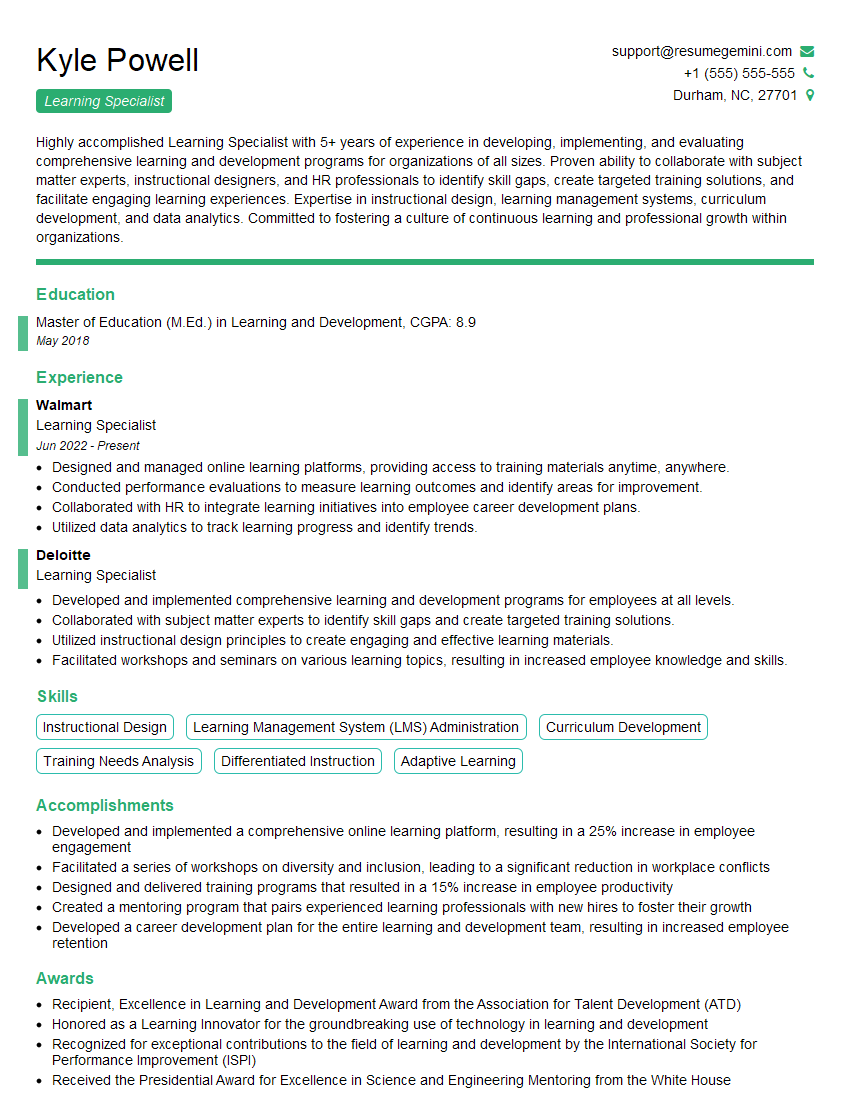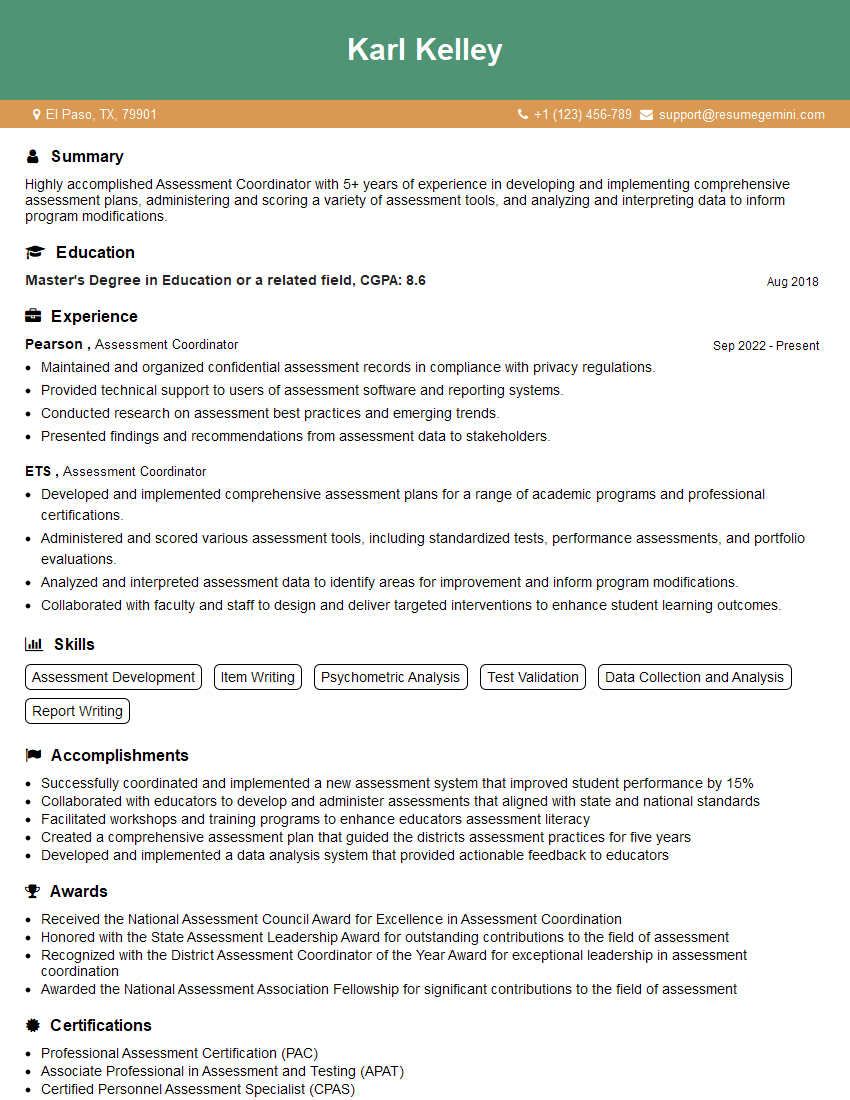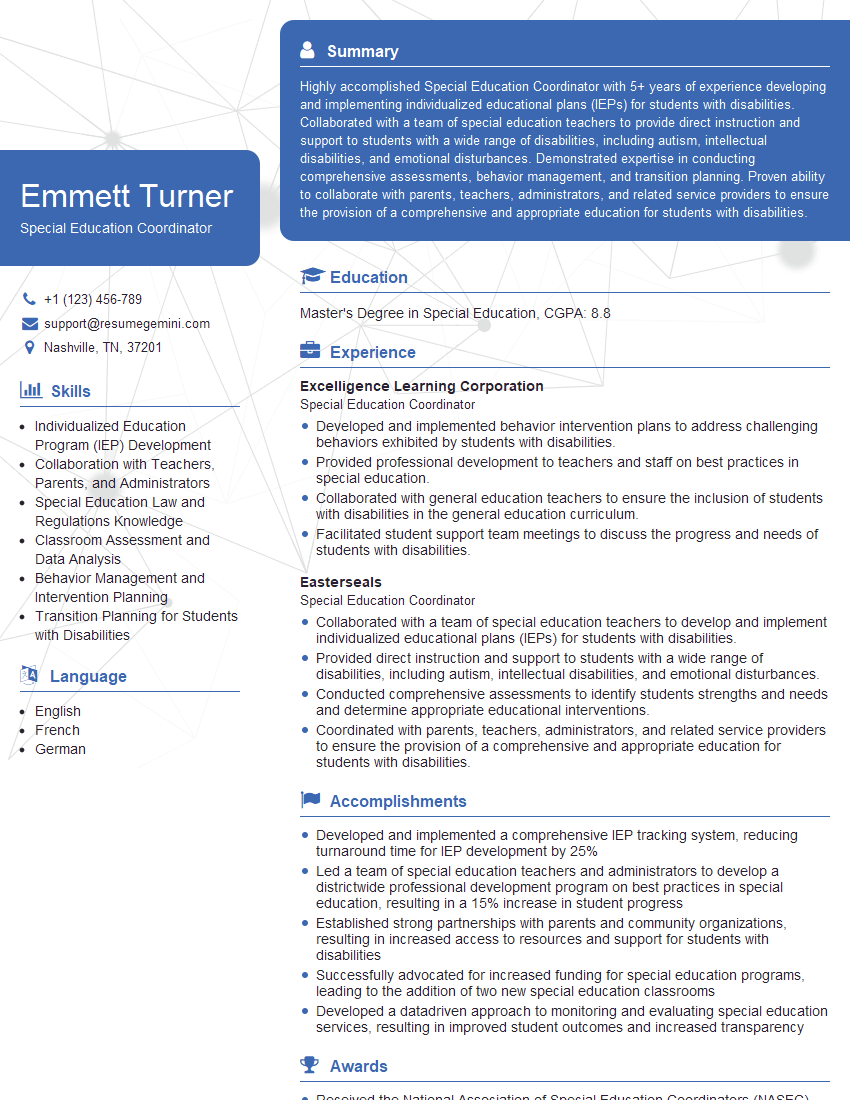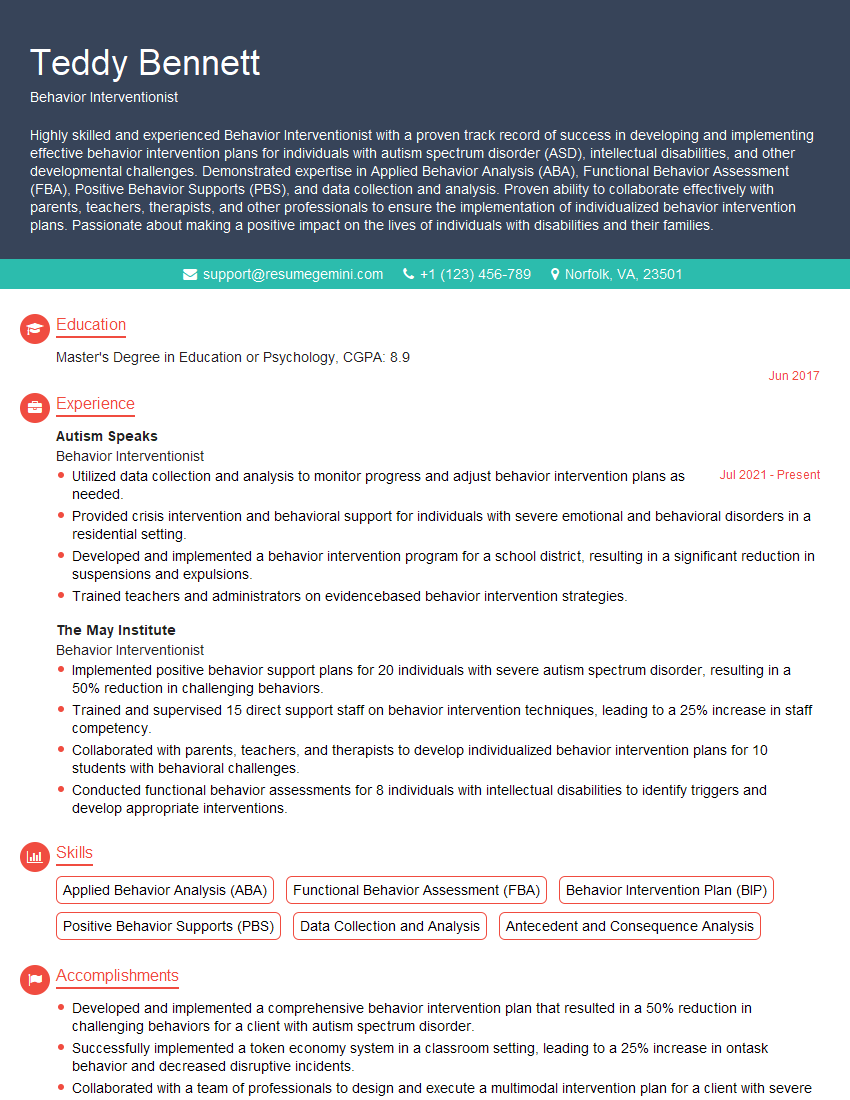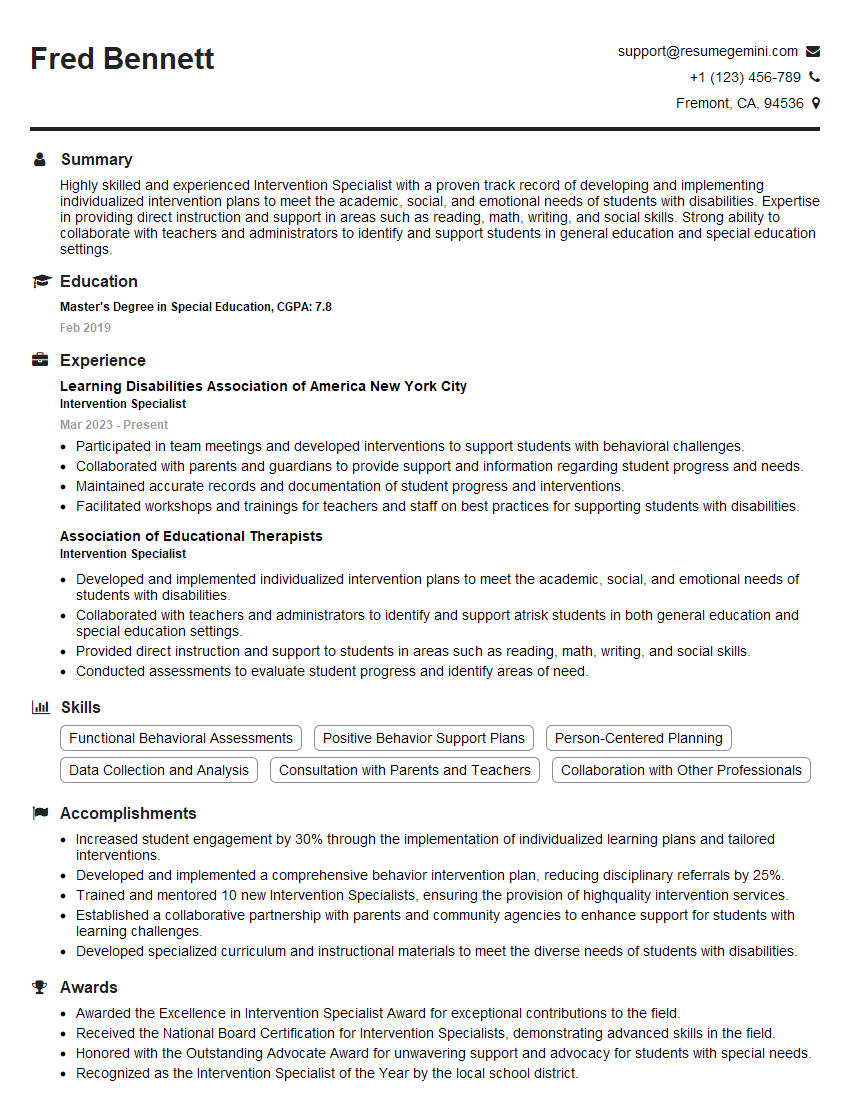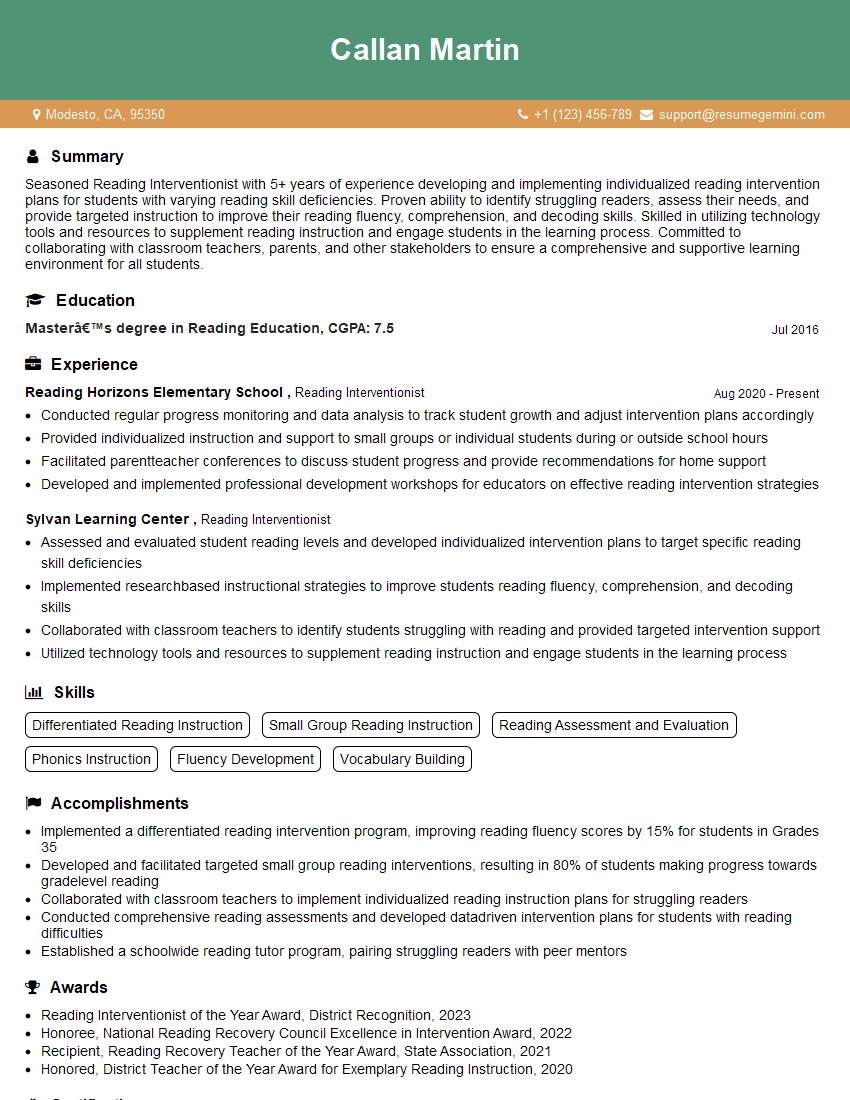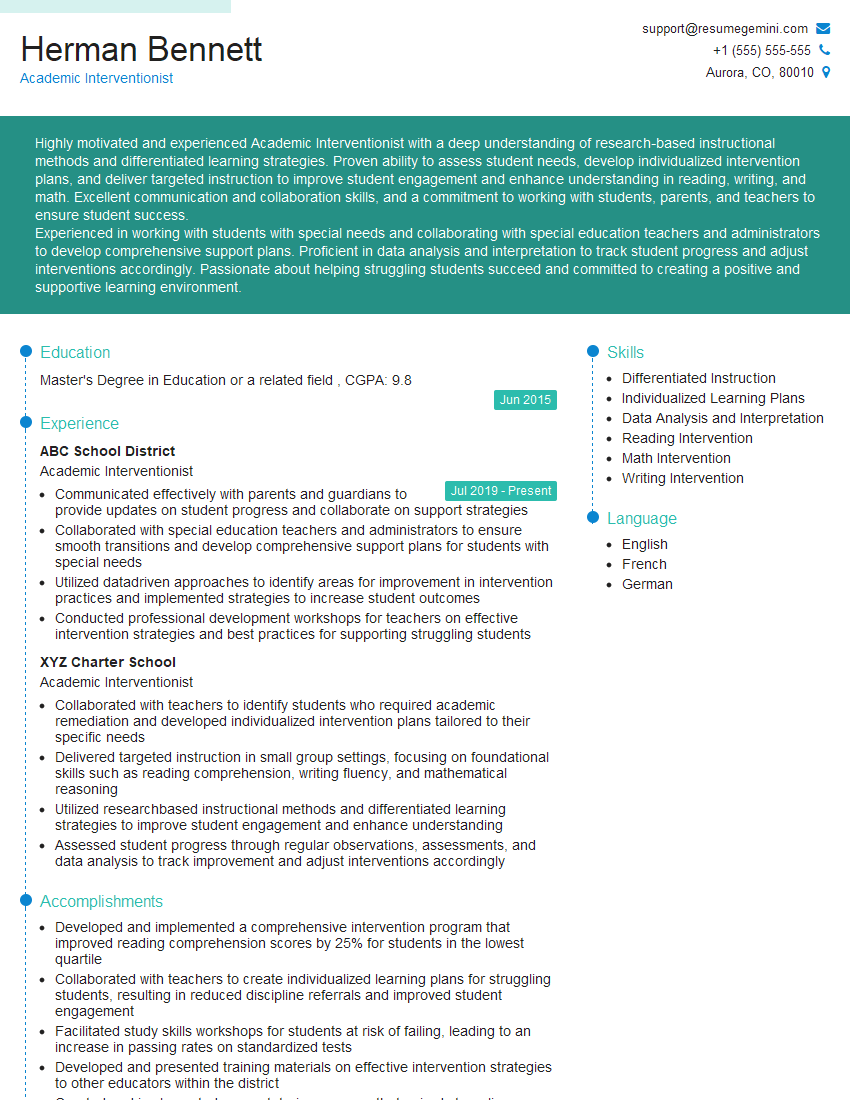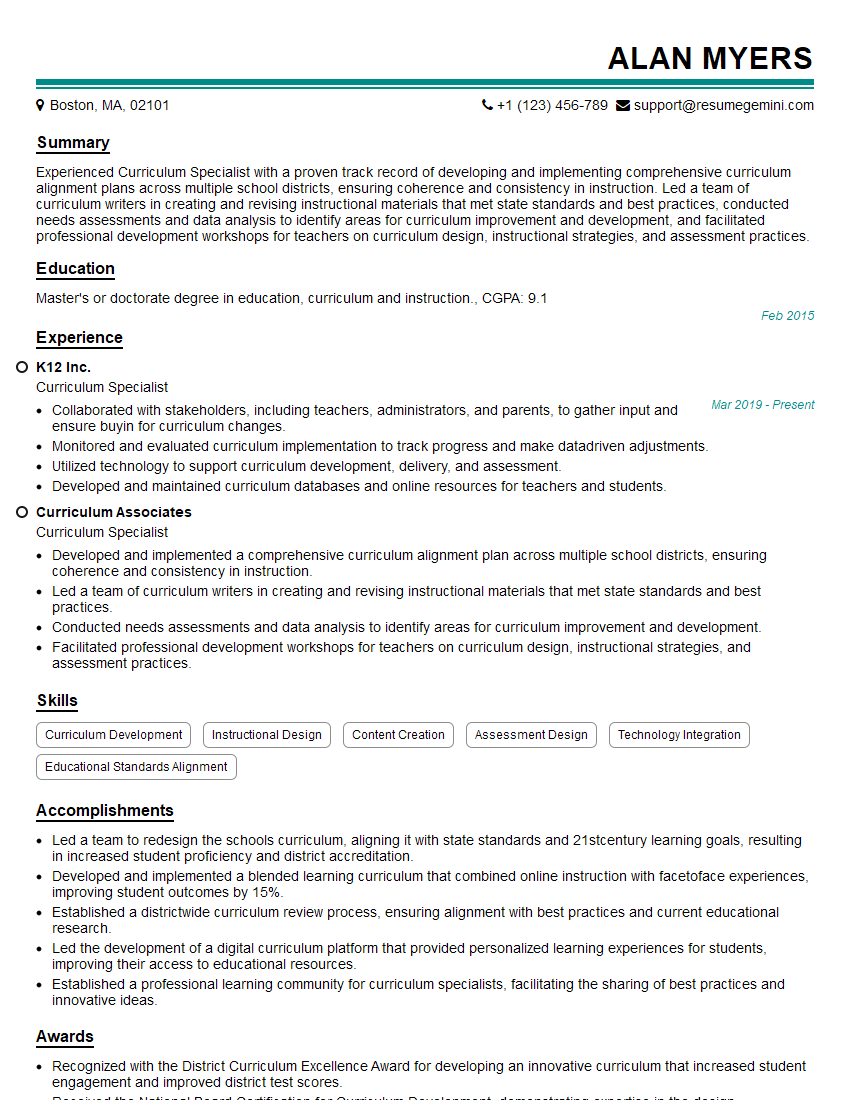The thought of an interview can be nerve-wracking, but the right preparation can make all the difference. Explore this comprehensive guide to Response to Intervention (RTI) interview questions and gain the confidence you need to showcase your abilities and secure the role.
Questions Asked in Response to Intervention (RTI) Interview
Q 1. Explain the three tiers of Response to Intervention (RTI).
Response to Intervention (RTI) is a multi-tiered system of support designed to provide struggling learners with increasingly intensive interventions. It’s like a tiered pyramid, with each level offering more focused and specialized help.
- Tier 1: Universal Instruction: This is the foundation, where all students receive high-quality, evidence-based instruction in the general education classroom. Think of it as the preventative layer – providing a solid base for all students. This includes well-planned lessons, differentiated instruction based on student needs, frequent monitoring of student progress, and positive classroom management techniques.
- Tier 2: Targeted Interventions: Students who are not making adequate progress in Tier 1 are moved to Tier 2. They receive supplemental instruction in small groups, focusing on specific skills identified as needing improvement. This is like giving extra support to those who need a bit of a boost. Interventions may include targeted reading groups, tutoring, or strategies aimed at addressing particular learning difficulties.
- Tier 3: Intensive Interventions: Students who continue to struggle in Tier 2 move to Tier 3, which involves highly individualized interventions. This might include one-on-one tutoring, specialized programs, or referral for special education services. It’s like intensive care for those who need significant extra help.
Q 2. Describe the role of data in informing RTI decisions.
Data is the lifeblood of RTI. It guides decision-making at every level, ensuring interventions are effective and tailored to individual student needs. We use data to identify students who are at risk, monitor their progress in response to interventions, and make adjustments as needed. Imagine trying to fix a car without knowing what’s wrong; that’s what RTI would be like without data.
For example, regular assessment data, such as curriculum-based measurement (CBM) scores, allows us to track a student’s progress on key skills (e.g., reading fluency, math facts). If a student’s data consistently falls below benchmarks, it signals a need for more intensive support, prompting a move to Tier 2 or Tier 3. The data isn’t just about scores; it includes qualitative information, such as observations of student behavior and work samples, giving a more comprehensive understanding of learning challenges.
Q 3. What are some effective instructional strategies used in Tier 1 interventions?
Effective Tier 1 interventions focus on proactive strategies to prevent learning difficulties from developing in the first place. They are characterized by high-quality teaching and robust assessment, ensuring all students are given the opportunity to succeed.
- Explicit Instruction: Clearly modeling concepts and skills, providing ample opportunities for guided practice, and offering frequent feedback.
- Differentiated Instruction: Tailoring instruction to meet the diverse needs of all learners by adjusting materials, activities, and learning environments. For instance, a teacher might provide different levels of reading material or offer hands-on projects for kinesthetic learners.
- Positive Behavior Interventions and Supports (PBIS): Creating a positive and supportive classroom environment that emphasizes positive behavior and minimizes disruptive behaviors. A well-established classroom routine contributes to this positive environment.
- Collaborative Learning: Using group work, peer tutoring, and other collaborative strategies to engage students and promote active learning. Students can benefit significantly from learning from and teaching each other.
- Frequent Monitoring of Progress: Using formative assessment measures to frequently track student learning and adjust instruction accordingly. Quick checks of understanding and short quizzes help ensure that all students are grasping the material before moving on.
Q 4. How do you identify students who need Tier 2 or Tier 3 interventions?
Identifying students needing Tier 2 or 3 interventions relies heavily on data analysis. We look for students whose progress is consistently below their peers. For example, a student might consistently score below grade level on CBM probes in reading, indicating a need for additional support. Other indicators include low scores on standardized tests, teacher observations of struggling behaviors or difficulty with specific skills, and parent concerns.
We use a variety of data points to avoid misidentification. A single low score isn’t enough; we analyze trends over time to ensure consistency in performance. The goal is to provide support as early as possible, preventing larger learning gaps from forming.
Q 5. What assessment tools are commonly used in RTI?
The assessment tools used in RTI are varied and depend on the student’s needs and the tier of intervention. However, some common tools include:
- Curriculum-Based Measurement (CBM): Frequent, short assessments that measure student performance on specific skills related to the curriculum. This provides continuous data for progress monitoring.
- Standardized Tests: Tests that compare student performance to national or state averages. While useful, they offer only a snapshot in time and may not capture individual learning needs completely.
- Informal Assessments: Teacher-made assessments, observations, and work samples that provide more detailed information on student strengths and weaknesses.
- Adaptive Assessments: These tests adjust the difficulty level based on the student’s responses, providing a more precise measure of skill mastery.
Q 6. Explain the difference between formative and summative assessment in RTI.
Formative and summative assessments play distinct roles in RTI.
- Formative assessments are ongoing, low-stakes assessments used to monitor student progress and adjust instruction. Think of them as ‘check-ins’ along the way. Examples include exit tickets, quick quizzes, and observations during class activities. This data helps guide instruction and adjust interventions in real time.
- Summative assessments are high-stakes assessments that evaluate student learning at the end of an instructional unit or period. They are used to determine overall progress and make decisions about student placement and instructional needs. Examples are unit tests or end-of-year exams. These provide a broader overview of learning.
In RTI, formative assessment is critical for guiding decisions about interventions and making necessary adjustments. Summative assessments offer a comprehensive picture of a student’s overall achievement.
Q 7. How do you collaborate with parents and other professionals in the RTI process?
Collaboration is paramount to the success of RTI. It involves ongoing communication and partnership among educators, parents, and sometimes specialists. Think of it as a team effort to best support the child’s needs.
- Parent Involvement: Regular communication with parents, keeping them informed about their child’s progress, interventions, and any concerns. Parent input is crucial for a holistic understanding of the child’s needs.
- Collaboration among Professionals: Regular meetings among teachers, special education staff, school psychologists, and other relevant professionals to discuss student progress, share data, and plan interventions. This coordinated approach leverages different expertise to provide the most effective support.
- Shared Decision-Making: All stakeholders collaborate to identify appropriate interventions, determine timelines, and regularly review and adjust the plan based on data. This ensures buy-in from everyone involved.
Effective communication strategies, such as regular progress reports, parent-teacher conferences, and team meetings, are crucial for maintaining open and productive relationships.
Q 8. Describe your experience with developing and implementing Individualized Education Programs (IEPs).
Developing and implementing Individualized Education Programs (IEPs) is a cornerstone of my work in special education. It involves a collaborative process, bringing together parents, teachers, administrators, and sometimes specialists to create a tailored plan for a student with identified disabilities. My experience spans various disability categories, including learning disabilities, speech impairments, and autism spectrum disorder.
The process begins with a comprehensive assessment of the student’s strengths and weaknesses, analyzing data from various sources such as standardized tests, classroom observations, and teacher feedback. This data informs the goals and objectives outlined in the IEP. For example, if a student struggles with reading fluency, the IEP might include specific goals targeting increased words-per-minute and improved accuracy.
I’m proficient in writing measurable and attainable goals, selecting appropriate interventions, and determining the frequency and duration of services. I’ve also had extensive experience in monitoring progress, making data-driven adjustments to the IEP as needed, and collaborating with parents to ensure that the IEP is effective and aligns with their aspirations for their child. A recent example involved a student with ADHD; we used a combination of behavior management strategies and assistive technology to improve his focus and organizational skills, resulting in significant academic gains. The success of this IEP was directly linked to consistent communication and collaboration with parents, leading to a truly supportive environment for the child.
Q 9. How do you differentiate instruction to meet the diverse needs of students in RTI?
Differentiation in Response to Intervention (RTI) is crucial. It’s about adjusting teaching methods and materials to meet the unique needs of each student. This isn’t simply about grouping students; it’s about tailoring instruction to individual learning styles, paces, and strengths.
Within the RTI framework, we use a tiered approach. Tier 1 involves high-quality, evidence-based instruction for all students. Tier 2 provides targeted interventions for students who aren’t making adequate progress in Tier 1. Tier 3 offers intensive, individualized support for students who continue to struggle despite Tier 2 interventions.
For example, in Tier 2, a student struggling with math might receive small-group instruction focusing on specific skills like multiplication facts, using manipulatives and differentiated practice sheets based on their learning preference (visual, auditory, kinesthetic). In Tier 3, the same student might receive one-on-one tutoring with a highly specialized teacher and use adaptive learning software customized to their individual needs. Differentiation encompasses varying the pace, complexity, methods, and support systems offered, ensuring every student has the tools they need to succeed.
Q 10. What are some common challenges in implementing RTI, and how have you addressed them?
Implementing RTI presents several challenges. One common issue is securing sufficient time and resources. Effective RTI requires dedicated time for planning, intervention delivery, and data analysis, which can be difficult in already resource-constrained schools. Another challenge is the need for consistent data collection and analysis. Accurate, ongoing monitoring is essential for making informed decisions about student progress, but it requires dedicated personnel and efficient systems. Finally, effective collaboration between teachers, specialists, and parents is vital for RTI success, but achieving this can sometimes be difficult due to scheduling conflicts or communication barriers.
I address these challenges by proactively seeking out collaborative partnerships with other professionals, developing efficient data management systems (for example, utilizing school-wide data platforms), and advocating for the necessary resources. I also create a strong communication infrastructure involving regular meetings, parent newsletters, and transparent reporting, fostering a shared understanding of the RTI process. Furthermore, I provide professional development opportunities to enhance staff capacity in data-based decision-making and intervention strategies.
Q 11. How do you monitor student progress within the RTI framework?
Monitoring student progress within RTI is ongoing and data-driven. We use a variety of methods, including curriculum-based measurement (CBM), formative assessments, and observations. CBMs involve frequent, brief assessments aligned with the curriculum, providing a snapshot of student performance over time. These assessments are typically administered weekly or bi-weekly. Formative assessments provide more qualitative data, offering insight into student understanding of concepts. Observations allow us to observe student behaviors and strategies in the classroom setting.
All this data is graphed and analyzed regularly. We look for trends in student performance to determine if interventions are effective. For example, if a student’s scores on CBM probes are not improving, we might adjust the intervention, change the intensity of support, or consider a referral for more intensive services. Regular monitoring allows for flexible adjustments and ensures that students receive the right support at the right time.
Q 12. Describe your experience with progress monitoring tools and data analysis.
My experience with progress monitoring tools and data analysis is extensive. I’m proficient in using various software programs to track student progress, such as Google Sheets, Excel, and specialized educational data management systems. I can efficiently graph data, identify trends, and make data-based decisions. I also use various formative and summative assessment tools to collect comprehensive data.
Beyond technical skills, my expertise lies in interpreting data meaningfully. I understand how to analyze patterns and identify which interventions are producing desired results. For instance, I can differentiate between a student’s consistent lack of progress, indicating a need for more intensive intervention, and a temporary plateau, which might simply require more time and consistent reinforcement. This requires a thorough understanding of the student’s individual learning needs and a strong ability to interpret various types of assessment data.
Q 13. How do you determine the effectiveness of an intervention?
Determining the effectiveness of an intervention is crucial. It relies on careful data analysis and a clear understanding of the intervention’s goals. We start by establishing clear, measurable goals for the intervention. Then, we use progress monitoring data to track the student’s progress towards those goals. This includes looking at the rate of improvement, the consistency of progress, and the overall change in the student’s performance.
Statistical significance isn’t always the sole metric; we also consider qualitative data, such as teacher and parent observations, student self-reports, and anecdotal records. For example, if a student’s test scores improve but their classroom behavior remains disruptive, the intervention’s overall effectiveness is questionable. A successful intervention demonstrably improves student performance while often leading to positive changes in attitudes and behaviors. If an intervention isn’t effective, we don’t hesitate to adjust it or try a different approach.
Q 14. What are some effective strategies for engaging parents in the RTI process?
Engaging parents in the RTI process is paramount. It requires open communication, transparency, and a collaborative approach. I start by establishing strong communication channels early on, informing parents about the RTI framework and their child’s progress. Regular meetings, phone calls, or emails keep parents informed, providing opportunities to discuss concerns and celebrate successes.
I use clear, non-technical language to explain complex concepts, ensuring parents understand their child’s needs and the interventions implemented. I also actively seek parental input, valuing their perspectives and insights into their child’s learning styles and home environment. Furthermore, I actively involve parents in goal setting, intervention selection, and progress monitoring, fostering a sense of shared responsibility and ownership. For example, providing parents with home activities that complement classroom instruction improves intervention effectiveness and builds a stronger home-school partnership. Parents are crucial partners in their children’s education, and their active involvement significantly improves the overall success of the RTI process.
Q 15. Explain the role of Universal Design for Learning (UDL) in RTI.
Universal Design for Learning (UDL) is a framework that guides the creation of flexible learning environments that cater to individual student needs. In the context of Response to Intervention (RTI), UDL plays a crucial role in proactively preventing learning difficulties by providing multiple means of representation, action and expression, and engagement. Instead of a one-size-fits-all approach, UDL ensures that instruction is accessible and adaptable to all learners from the outset.
For example, in a math lesson on fractions, UDL principles would suggest offering various ways for students to learn the material: visual representations (diagrams, videos), auditory explanations (lectures, podcasts), and kinesthetic activities (manipulating fraction tiles). Students can also choose how they demonstrate their understanding – through written tests, oral presentations, or project-based assessments. This proactive approach helps identify struggling students early on, even before they fall significantly behind.
Career Expert Tips:
- Ace those interviews! Prepare effectively by reviewing the Top 50 Most Common Interview Questions on ResumeGemini.
- Navigate your job search with confidence! Explore a wide range of Career Tips on ResumeGemini. Learn about common challenges and recommendations to overcome them.
- Craft the perfect resume! Master the Art of Resume Writing with ResumeGemini’s guide. Showcase your unique qualifications and achievements effectively.
- Don’t miss out on holiday savings! Build your dream resume with ResumeGemini’s ATS optimized templates.
Q 16. How do you ensure fidelity of implementation in RTI?
Ensuring fidelity of implementation in RTI requires a multi-faceted approach focusing on monitoring, training, and ongoing support. It’s not enough to simply adopt the RTI model; it needs to be implemented consistently and accurately across all tiers of support. This involves regular data review to track student progress, consistent application of evidence-based interventions, and ongoing professional development for staff.
Specifically, we use:
- Data-based decision making: Regularly analyzing student progress data (e.g., curriculum-based measurement, formative assessments) to inform intervention adjustments.
- Checklists and protocols: Standardizing procedures for delivering interventions to ensure consistency across classrooms and teachers.
- Observation and coaching: Providing ongoing support and feedback to teachers through classroom observations and coaching sessions, focusing on the accurate implementation of interventions.
- Team meetings: Regularly reviewing student data and adjusting intervention plans as needed in collaborative team meetings involving teachers, specialists, and administrators.
Think of it like baking a cake. A recipe (RTI model) provides the framework, but consistent measuring (data collection), following instructions (intervention fidelity), and adjusting based on the result (data-based decisions) are crucial for a successful outcome. Lack of fidelity leads to ineffective interventions and misidentification of students needing support.
Q 17. Describe your experience with behavior intervention plans (BIPs).
I have extensive experience developing and implementing Behavior Intervention Plans (BIPs). A BIP is a plan designed to address a student’s challenging behavior using positive behavior supports. It’s a crucial component of RTI, particularly for students exhibiting behaviors that interfere with their learning or the learning of others. The process always starts with a Functional Behavior Assessment (FBA) to identify the function of the behavior (why the student is engaging in it).
For example, I worked with a student who frequently disrupted class by yelling out. Through the FBA, we discovered the yelling was a way to gain attention. The BIP we developed focused on providing positive reinforcement for appropriate behavior (e.g., praising the student for staying quiet) and teaching alternative ways to get attention (e.g., raising their hand). Regular monitoring and data collection were vital to measure the BIP’s effectiveness and make necessary adjustments. The BIP is never static; it’s a living document that evolves based on student response.
Q 18. How do you address student behavior within the RTI framework?
Addressing student behavior within the RTI framework involves a tiered approach. At Tier 1, universal strategies are implemented for all students to create a positive classroom environment and proactively prevent problem behaviors. This includes establishing clear expectations, positive reinforcement systems, and teaching social-emotional skills.
If a student’s behavior doesn’t improve at Tier 1, a more intensive Tier 2 intervention is implemented, often involving small group instruction focusing on specific behavioral skills. Finally, Tier 3 involves individualized interventions, such as a BIP, for students whose behaviors significantly disrupt their learning or the learning of others. Data is collected at each tier to monitor the effectiveness of the interventions and inform decisions regarding the student’s support needs. Collaboration with parents and relevant professionals is vital throughout the process.
Q 19. What is your understanding of the legal and ethical considerations of RTI?
Legal and ethical considerations in RTI are paramount. RTI must adhere to the principles of due process, ensuring students receive fair and equitable access to services. Confidentiality is crucial, protecting student data and privacy. Parents must be involved in all decision-making processes regarding their child’s education, informed consent is necessary before implementing any interventions, and any assessments used must be culturally and linguistically appropriate.
Furthermore, the Individuals with Disabilities Education Act (IDEA) significantly impacts RTI implementation. The identification of students with disabilities often begins with RTI, and appropriate procedures must be followed to comply with IDEA’s mandates. Failure to adhere to these legal and ethical considerations can have serious consequences, including legal challenges and ethical breaches.
Q 20. Describe your experience with using technology to support RTI.
Technology plays a significant role in supporting RTI. Educational software and apps can provide targeted interventions, personalized learning experiences, and efficient data collection. For example, I have used adaptive learning platforms that adjust the difficulty of assignments based on student performance, providing immediate feedback and individualized support. Data management systems are essential for tracking student progress, facilitating data-based decision-making, and ensuring accountability.
Moreover, technology can enhance communication and collaboration among teachers, specialists, and parents. Online platforms facilitate the sharing of student data, intervention plans, and progress reports, improving the efficiency and effectiveness of the RTI process. The key is selecting appropriate technology that aligns with the specific needs of the students and the goals of the intervention.
Q 21. How do you adapt interventions based on student response?
Adapting interventions based on student response is crucial for the success of RTI. Regular monitoring of student progress, through data collection and ongoing assessment, is essential to determine if an intervention is effective. If a student isn’t making adequate progress, the intervention needs to be adjusted. This might involve changing the intensity, duration, or type of intervention.
For example, if a student isn’t responding to a Tier 2 intervention, we might increase the frequency of the intervention sessions, modify the materials used, or consider adding a different intervention strategy. It’s a cyclical process of assess, adjust, and reassess. The key is to be flexible and responsive to the student’s unique learning needs and make data-driven adjustments to ensure they receive the support they need to succeed.
Q 22. What are some common barriers to effective RTI implementation?
Effective RTI implementation faces numerous hurdles. These barriers often intertwine, creating complex challenges. Let’s explore some key areas:
- Lack of adequate resources: This includes insufficient funding for staffing, training, materials, and assessments. Without these essentials, providing effective interventions becomes extremely difficult.
- Insufficient professional development: RTI requires specialized training in data analysis, intervention strategies, and collaborative practices. Without ongoing professional development, educators may lack the skills and knowledge to implement RTI effectively.
- Inconsistent implementation across schools or districts: Variations in fidelity to the RTI model can significantly impact its efficacy. A lack of standardization can lead to inequitable access to services and inconsistent outcomes.
- Lack of buy-in from stakeholders: Successful RTI requires the active participation and support of all stakeholders, including teachers, administrators, parents, and students. Resistance or lack of understanding can significantly hinder implementation.
- Difficulties with data collection and analysis: RTI relies heavily on data-driven decision-making. Inconsistent or incomplete data collection, coupled with a lack of skills in data analysis, can lead to poor decisions and ineffective interventions. This includes difficulties with timely data analysis to guide intervention adjustments.
- Time constraints: Implementing RTI effectively requires significant time for planning, instruction, data collection, analysis, and collaboration. The demands of a busy school schedule often limit the time available for these crucial activities.
For example, I once worked in a school where budget cuts resulted in limited access to specialized assessments, hindering our ability to accurately identify students’ specific learning needs and tailor interventions accordingly.
Q 23. How do you ensure equitable access to services within the RTI framework?
Ensuring equitable access to RTI services is paramount. This requires a multi-faceted approach focusing on proactive identification of students who need support, regardless of background or prior performance. Here’s how I approach this:
- Universal screening: Employing standardized, unbiased screening measures to identify students at risk for academic or behavioral difficulties, irrespective of their demographics. This helps avoid relying on subjective referrals.
- Culturally responsive practices: Interventions should be tailored to the cultural backgrounds and learning styles of students. This might involve utilizing culturally relevant materials, adapting teaching methods, and collaborating with families to understand students’ needs.
- Differentiated instruction: Providing a range of instructional approaches and materials to cater to diverse learning styles and needs. This ensures all students receive instruction that is appropriately challenging and supportive.
- Addressing systemic biases: Critically examining school policies and practices to identify and eliminate any potential biases that could disproportionately affect certain student groups. This might involve reviewing referral patterns, teacher expectations, and disciplinary procedures.
- Building strong home-school connections: Regular communication with families is crucial to ensure their understanding and involvement in the RTI process. This helps to provide a consistent and supportive learning environment for students.
- Ongoing monitoring and evaluation: Continuously evaluating the effectiveness of RTI services and making adjustments as needed to ensure equitable outcomes for all students. This ensures we are addressing any emerging disparities.
For instance, I’ve worked with schools to develop culturally relevant curriculum materials and to provide professional development for teachers on culturally responsive teaching practices, aiming for equitable outcomes for all students.
Q 24. Describe your experience with creating and utilizing data-based decision making processes.
Data-based decision making (DBDM) is the cornerstone of effective RTI. My experience involves a cyclical process: collecting data, analyzing it, making adjustments to instruction, and re-evaluating outcomes.
- Data Collection: This includes using a variety of assessment tools, such as universal screeners, progress monitoring probes, curriculum-based measurements, and observations. I use a combination of formative and summative assessments to track student progress effectively.
- Data Analysis: I utilize both descriptive and inferential statistics to analyze data trends and identify patterns. I create graphs and charts to visualize student progress and inform intervention decisions. This might involve looking at trends in performance over time or comparing student performance across different groups.
- Intervention Adjustment: Based on the data analysis, I adjust interventions, either by intensifying current interventions or implementing new ones. This is an iterative process. For example, if a student isn’t responding to an intervention, I may adjust the intervention’s intensity, frequency, or components.
- Evaluation: I regularly monitor student progress and re-evaluate the effectiveness of the interventions. This ensures interventions are working and allows for necessary changes.
For example, in a previous role, we used data from weekly progress monitoring probes to determine the effectiveness of our reading interventions. When we noticed a student wasn’t making adequate progress, we modified the intervention by increasing the frequency of one-on-one tutoring sessions and incorporating more multi-sensory activities.
Q 25. Explain your experience with various intervention models (e.g., explicit instruction, peer tutoring).
I have extensive experience with various intervention models, adapting them to suit individual student needs. Here are a few examples:
- Explicit Instruction: This model is characterized by clear and systematic instruction, with a focus on modeling, guided practice, and independent practice. I frequently use explicit instruction for teaching foundational skills in reading and math. I break down complex skills into smaller, manageable steps, providing students with ample opportunities to practice and receive feedback.
- Peer Tutoring: This approach involves pairing students to work together on academic tasks. I’ve used peer tutoring successfully to improve reading fluency and math fact mastery. This provides students with opportunities for collaborative learning and social interaction while enhancing their academic skills.
- Differentiated Instruction: This approach involves tailoring instruction to meet the diverse learning needs of students. I regularly differentiate instruction by adjusting the level of support, the complexity of tasks, and the methods of instruction. This might include providing graphic organizers, modifying assignments, or using various assessment tools.
- Strategic Instruction Model (SIM): I’ve successfully implemented the SIM model to teach students self-regulated learning strategies, such as goal setting, self-monitoring, and self-evaluation. This empowers students to take ownership of their learning.
For instance, I once used explicit instruction to teach a student with dyslexia phonics skills, breaking down the sounds into smaller components, followed by peer tutoring to practice blending and segmenting words. This combined approach produced notable progress.
Q 26. How do you communicate effectively with students, parents, and colleagues regarding RTI progress?
Effective communication is crucial for successful RTI implementation. I prioritize clear, concise, and frequent communication with students, parents, and colleagues.
- Students: I use positive reinforcement and clear expectations to motivate students and provide regular feedback on their progress. I make sure to explain the purpose of the interventions and celebrate their successes.
- Parents: I maintain open communication channels with parents, providing regular updates on their child’s progress, explaining the RTI process, and inviting their input and collaboration. I utilize various methods like email, phone calls, progress reports, and parent-teacher conferences.
- Colleagues: I engage in regular collaboration with teachers, specialists, and administrators, sharing data, discussing student needs, and coordinating interventions. I participate in team meetings, co-teaching opportunities, and informal discussions to ensure a unified approach.
For example, I’ve developed a system of weekly progress reports for parents that visually represent student progress. This system increases transparency and facilitates open discussions about how to further support the student’s academic success. I also create visual aids and use simple language to clearly explain complex concepts to both students and parents.
Q 27. What professional development activities have you pursued related to RTI?
I am committed to ongoing professional development in RTI. I’ve participated in numerous workshops, conferences, and training programs. Some key areas of my professional development include:
- Data-based decision making: I’ve completed training on various data analysis techniques, including using spreadsheets and statistical software to track student progress and inform instructional decisions.
- Intervention strategies: I’ve received training on a variety of evidence-based intervention strategies, including explicit instruction, peer tutoring, and differentiated instruction.
- Culturally responsive teaching: I’ve participated in professional development on culturally responsive teaching practices, learning how to adapt my instruction to meet the diverse needs of my students.
- Collaboration and communication: I’ve received training on effective communication and collaboration strategies, learning how to work effectively with colleagues, parents, and students.
My most recent professional development involved a three-day intensive workshop on using data to inform instructional decisions. This workshop significantly enhanced my ability to analyze data effectively and make data-driven decisions.
Q 28. Describe a time when you had to modify an intervention based on student needs.
In one instance, I was working with a student struggling with reading fluency. Initially, we implemented a program focusing solely on repeated reading. However, after several weeks of progress monitoring, the data showed minimal improvement.
I realized the intervention wasn’t adequately addressing the student’s underlying phonological awareness deficits. Therefore, I modified the intervention to include explicit instruction on phonemic awareness skills, such as rhyming, syllable segmentation, and phoneme blending, before focusing on fluency. I also incorporated multi-sensory activities to cater to the student’s learning style.
This modification resulted in significant improvement in the student’s phonological awareness skills and, consequently, reading fluency. The data clearly showed the positive impact of this change. This experience underscored the importance of continuous data analysis and flexibility in adjusting interventions to meet individual student needs. It reinforced the iterative and adaptive nature of the RTI process.
Key Topics to Learn for Response to Intervention (RTI) Interview
- Understanding the RTI Process: Learn the three-tiered model, including prevention, intervention, and intensive intervention levels. Understand the purpose and implementation of each tier.
- Data-Based Decision Making (DBDM): Master the use of assessment data to inform instructional decisions. Practice interpreting various assessment results and using them to adjust interventions.
- Effective Instructional Strategies: Explore evidence-based strategies for different learning needs, including differentiated instruction, explicit instruction, and positive behavior interventions and supports (PBIS).
- Collaboration and Communication: Understand the importance of collaboration with parents, teachers, administrators, and specialists. Practice effective communication strategies for sharing assessment data and intervention plans.
- Legal and Ethical Considerations: Familiarize yourself with relevant laws and regulations regarding special education and student rights within the RTI framework.
- Progress Monitoring and Evaluation: Learn various methods for tracking student progress and using data to determine the effectiveness of interventions. Understand how to adjust interventions based on ongoing monitoring.
- Technology Integration in RTI: Explore how technology can support data collection, progress monitoring, and the delivery of interventions.
Next Steps
Mastering Response to Intervention (RTI) principles and practices opens doors to exciting career opportunities in education and related fields. A strong understanding of RTI demonstrates your commitment to student success and your ability to utilize data-driven approaches to improve learning outcomes. To significantly enhance your job prospects, creating an ATS-friendly resume is crucial. ResumeGemini can help you build a professional and impactful resume that highlights your RTI expertise. ResumeGemini provides examples of resumes tailored to Response to Intervention (RTI) positions, ensuring your application stands out from the competition. Take advantage of these resources and confidently present yourself as a highly qualified RTI professional.
Explore more articles
Users Rating of Our Blogs
Share Your Experience
We value your feedback! Please rate our content and share your thoughts (optional).
What Readers Say About Our Blog
Hi, I’m Jay, we have a few potential clients that are interested in your services, thought you might be a good fit. I’d love to talk about the details, when do you have time to talk?
Best,
Jay
Founder | CEO
